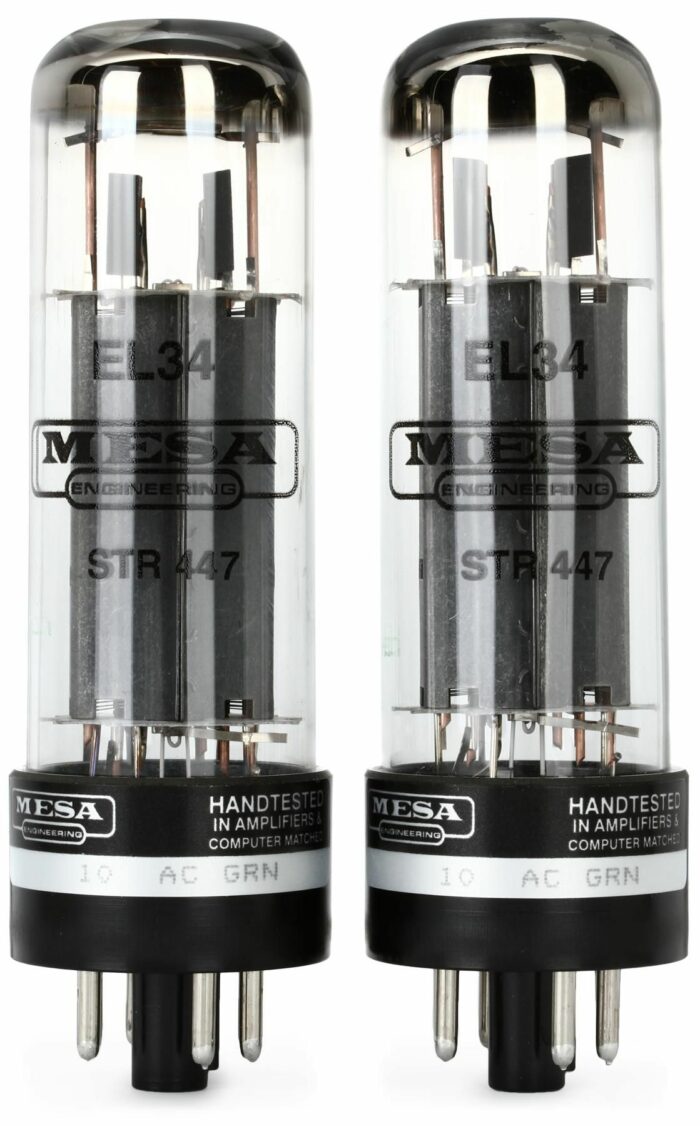Contents
Nowadays, all guitarists worth their salt understand the importance of finding the right tubes for the right amplifiers. Consequently, it’s not uncommon for people to pit tubes against each other while shopping for amp tubes and EL84 vs. EL34 is a prime example. EL84 tubes feature a low power rating which makes them ideal for small rooms while the high power rating of EL34 tubes fit large audiences. If you want to know which tube is the superior model between the two, check out my article.
A Comparison Of The Tubes
| EL34 | EL84 | |
| Power rating | 25 – 30 Watts | 6 -10 watts |
| Tone | Crunchy and crisp sound with prominent low-end and midrange. | Compressed, pure and balanced tone with warm overdrive as well as clear midrange. |
| Size | Large, wide glass envelope. | Small, narrow glass envelope. |
| Compatible amps | Marshall, Hiwatt and other classic rock amps. | Vox, Fender and small boutique amplifiers. |
| Associated genres | Classic British rock, hard rock and metal tones. | Blues, jazz, vintage rock and low-volume applications. |
| Bias adjustment | High bias voltages. | Low bias voltages. |
EL84 Vs. EL34: A Summary
Wattage And Headroom
Compared to their EL34 counterparts, EL84 tubes have lower wattage and less headroom. As a result, EL84 usually distorts and breaks up at low volume levels which provide tube saturation and warm overdrive tones. In the case of EL34 tubes, they deliver ample headroom in addition to high output. Unsurprisingly, EL34 only distorts at high volumes and proves popular among those who prioritize clean guitar tones.
Applications
EL84 tubes give a good account of themselves in apartment studios and other locations that demand low volume levels. They excel in producing warm, harmonically rich tones at low volumes and help people achieve clear tones. About EL34 tubes, as they produce substantially loud sounds when pushed into overdrive, they will be poor choices for apartment studios. If you need something for gigs in open space, go for EL34.
Tone
The compressed and pristine tone of EL84 tubes is balanced and harmonically rich. In use, the tubes emit warm and clear midrange frequencies appropriate for gentle and soft genres. For EL34 tubes, they create a crunchy and crispy sound with a distinct low-end and midrange. When pushed into overdrive, they create forceful and explosive distortion that fits iconic British rock.
Versatility
Because of their distinct tonal characteristics, EL84 tubes have mediocre versatility and won’t adapt well to a lot of genres. At the moment, they see extensive use in genres that require clarity and warmth like blues, jazz, classic rock, etc. Regarding EL34 tubes, they score well in terms of versatility and support a wide range of genres. Today, quite a few rock and metal players prefer to use EL34 owing to their ability to generate high-gain distortion and a powerful middle presence.
Verdict
On average, EL34 tubes come out on top in EL84 vs. EL34 since they guarantee a high level of versatility. Given enough tweaks, EL34 can work like the EL84, but you can’t get the same result in reverse. EL34 puts together high-quality sound at high volume and works well in various situations that EL84 tubes won’t.
Maintenance Of Amp Tubes: Recommendations
Practice Proper Ventilation And On/Off Procedures
Make sure that your amplifier has enough ventilation to disperse the heat produced by the tubes. Tube longevity will be drastically reduced by overheating so avoid obstructing cooling vents and place the amplifier in a well-ventilated place. Besides that, stick to power-on and power-off procedures regardless of settings. Allow the amplifier to warm up for a few minutes before using it and only switch it off when it has cooled.
Adjust Bias, Match Impedance And Replace Tube
- Modify the tubes’ bias (quiescent current) regularly according to the manufacturer’s specifications. By doing so, you can ensure consistent wear and tear which extends tube longevity.
- If you come across tubes that need to be replaced, it’s best to replace the whole set at once. Mixing old and new tubes can have an impact on performance and lifespan.
- Set the impedance of the amplifier to correspond with the cabinets you’re using. Using incorrect impedance settings can strain both the amp and the tubes.
Voltage check, storage, and cleaning
Check the voltage provided to the amplifier regularly to determine whether it is within the manufacturer’s suggested range. Voltage variations can affect tube performance as well as lifespan so keep an eye out for them. The tone generated by the tube power amplifier can be influenced by dirt and dust. Keep the unit clean by regularly cleaning dust and debris from the chassis, vents, and controls.

Hi music fan! I am Jeff. Hope that you enjoy some stuff I shared here in my personal blog.
About myself, Currently I am in charging as Artist Manager/Music Supervisor at 72 Music Management. I did managed album to Grammy Award in 2017 with 7 Nominations from 2014-2020 and had the opportunities to work with : A.J. Croce, Blind Boys of Alabama, Bobby Rush, Dom Flemons, Dustbowl Revival, Sarah Grace
Governor of the Memphis Chapter of The Recording Academy is one of a award that I am lucky to achieved.



